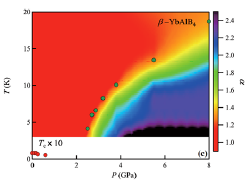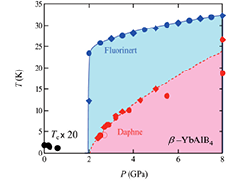Pressure-Induced Magnetic Transition Exceeding 30 K in the Yb-based Heavy-Fermion β-YbAlB4
Nakatsuji and Uwatoko Groups
Intermetallic heavy-fermion (HF) compounds, based mostly on Ce, Yb, or U, undergo a quantum phase transition at zero temperature induced by the competition between Kondo effects and intersite magnetic RKKY (Ruderman-Kittel-Kasuya-Yosida) interaction. In these materials, various types of exotic phenomena such as non-Fermi-liquid behaviors and unconventional superconductivity (SC) have been observed near a quantum critical point (QCP). The delicate balance associated with the QCP can be tuned by varying control parameters such as magnetic field, chemical doping, and external pressure. In particular, for the Yb-based HF systems, long-range magnetic order is expected to be stabilized at high pressure. This is because the 4f moments are generally known to become more localized by reducing volume, in sharp contrast to their Ce-based counterparts. For β-YbAlB4, in which recently observed HF superconductivity at 80 mK and the QCP at zero field at ambient pressure [1-3], of interest is how unconventional quantum criticality observed without tuning, associated with magnetic order that is expected to emerge under high pressure.

Fig. 1. Pressure-temperature phase diagram for β-YbAlB4 with a contour plot of the power-law exponent α, which is defined using ρ = ρ0 + ATα.

Fig. 2. Pressure-temperature phase diagram for β-YbAlB4 using two different pressure-transmitting media, Daphne 7373 (red symbols) and Fluorinert (blue symbols), respectively. The phase-transition temperature TM is determined from the anomalies in the temperature derivative of the resistivities, dρab/dT. Solid and open circles mark the transitions determined by the electrical resistance obtained from the cubic-anvil and piston cylinder- type pressure measurements, respectively. The blue solid line is a guide for the eye. The red dashed line is a fit of our data to the function of (P − Pc0)2/3 expected for a 3D antiferromagnetic ordering.
Here we report the results of our recent transport study on the HF superconductor YbAlB4 under pressure [4]. Measurements of the electric resistivity ρ(T) under pressure up to 8 GPa were performed on high-quality single crystals of the Yb-based heavy-fermion system β-YbAlB4 in the temperature range 2 < T < 300 K. In the resistivity data, we observed pressure-induced magnetic ordering above the critical pressure Pc ∼ 2 GPa. (See Fig. 1) Moreover, the clear difference in the phase diagram of Fig. 2 under pressure using two types of pressure media indicates that the transition temperature may be further enhanced under application of uniaxial pressure. With pressure, this phase-transition temperature TM is enhanced, reaching 32 K at 8 GPa, which is the highest transition temperature so far recorded for the Yb-based heavy-fermion compounds. The power-law exponent α in ρ = ρ0 + ATα below TM gradually changes from 3/2 to 5/2 with increasing pressure from 2 to 8 GPa (See Fig. 1). In contrast, the resistivity exhibits a T - linear behavior in the temperature range 2 < T < 20 K and is insensitive to pressure below Pc. In this pressure regime, the magnetization is also nearly independent of pressure and shows no anomaly above 2 K. Our results indicate that a QCP for β-YbAlB4 is also located near Pc in addition to the strange metal region near the ambient pressure. While almost pressure independent resistivity and magnetization are observed in the pressure range 0 < P < 2 GPa, the magnetic phase transition of β-YbAlB4 was suddenly found at P > 2 GPa.
Significantly, the phase transition TM of β-YbAlB4 reaches 32 K under 8 GPa and is expected to be further enhanced at higher pressure. Such high magnetic transition temperatures over 10 K have never been achieved in Yb-based HF materials. Generally, because the f-electron moment is sufficiently localized, the magnetic ordering temperatures in HF compounds is often observed below around 10 K. In particular, that of Yb-based HF should be lower than that of Ce-based HF because the Yb f-electron is usufally more localized than that for Ce.
In previous work for β-YbAlB4, it is reported that the state showing unconventional critical behavior (the SC phase and ambient-pressure quantum criticality) is separated from this magnetically ordered state by the Fermi-liquid phase [5]. Of high interest is the fact that the non-Fermi-liquid state at ambient pressure robustly persists up to a critical pressure of around 0.4 GPa. Generally, the HF compounds display quantum criticality at the border of magnetism. Thus, these are not features that are expected for magnetically mediated superconductivity. The Yb-based heavy-fermion with non-integer valence may exhibit critical phenomena with not only spin fluctuations but also valence fluctuations at quantum criticality. This valence fluctuation is presumably the key to understanding the origin of the extensive region of the quantum criticality found near ambient pressure and the extremely high ordering temperature of around 30 K found under high pressure.
References
- [1] Y. Matsumoto, S. Nakatsuji, K. Kuga, Y. Karaki, N. Horie, Y. Shimura, T. Sakakibara, A. H. Nevidomskyy, and P. Coleman, Science 331, 316 (2011).
- [2] K. Kuga, Y. Karaki, Y. Matsumoto, Y. Machida, and S. Nakatsuji, Phys. Rev. Lett. 101, 137004 (2008).
- [3] S. Nakatsuji, K. Kuga, Y. Machida, T. Tayama, T. Sakakibara, Y. Karaki, H. Ishimoto, S. Yonezawa, Y. Maeno, E. Pearson et al., Nat. Phys. 4, 603 (2008).
- [4] T. Tomita, K. Kuga, Y. Uwatoko, and S. Nakatsuji, Phys. Rev. B 94, 245130 (2016).
- [5] T. Tomita, K. Kuga, Y. Uwatoko, and S. Nakatsuji, Science 394, 506 (2015).
